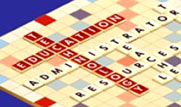
 |
| [ ASET ]
[ Proceedings Contents ] |
Research into students in the Middle Years of schooling - years 5-9, has characterised many students as lacking motivation, engagement and enjoyment in schooling, having poor literacy skills, being low achievers, a predominance of under-achieving boys, increased behaviour problems and large achievement differences between classes.[1]
Obviously changes are required to address these issues and teachers and leaders in both Primary schools {years 5-6} and secondary schools {years 7-9} are working towards developing curriculum and teaching practices which motivate, engage and allow students to experience success.
Developmentally appropriate curriculum and teaching practices recommend learning which includes:[2]
Students today are Internet savvy in Primary School, indeed before they arrive in years 5/6. The Australian Bureau of Statistics data for the September 2000 quarter showed 4.2 million active internet subscribers with capital cities accounting for 74% of subscribers and 84% of the download.[3]
The Internet is spreading much more quickly than did printed works. In fact, the Internet is one of the fastest growing communications media in world history. It has taken the World Wide Web just 4 years to achieve an audience of 50 million users, compared to 38 years for radio, 16 years for personal computers, and 13 years for television.[4]
Students today cruise the Information Superhighway, conduct searches, use a variety of search engines, download images and music, in effect are digitally literate users. They respond to colour, images, movement and sounds more readily than print based media and 74% of them have computers at home with Internet access. So, why not use the medium to engage their interests and create some learning?
The creation of personal web sites using Dreamweaver[5], Flash and Adobe PhotoShop and the incorporation of digital images and sound has brought to life and made relevant student research, it has changed the "research project" tag and given a valid and relevant audience for the writing tasks, as well as focusing on the CSF outcomes relevant to these year levels.
Web authoring is a valid and authentic learning process appropriate to the digital age which addresses the key criteria for successful Middle Years of Schooling teaching and learning practices. As well as developing skills in technology, design and creation which are relevant to today's world, it is:
Using the technology design model9 Investigate, Design, Produce, Evaluate}as a scaffold, students begin to design their own website. I find that using a mapping program, such as Inspiration 10 is and aid in mapping their site, linking pages and keeping control of the site.
The lesson to introduce the skills of Dreamweaver is short. Students with a good grasp of word processing or publishing software quickly adapt to the different formatting functions and a short handout is another scaffold.
Handouts also increase students' independent learning skills, collaborative work with peers and reduce reliance on the teacher.
The second lesson is always relating to images and graphics - these students are visually attuned and find graphics an important component of websites. Flash buttons and Adobe Photoshop for image manipulation are short clinic activities and again are supported by handouts.
By incorporating use of new software, Internet research, publishing to a valid audience and catering to students' individual needs, abilities and interests, this learning experience has resulted in work of a much higher calibre, students who are motivated, engaged and actively pursue research.
But what exactly is it which engages students and results in work of such a high standard?
The penultimate task is to publish and share students work. The thrill of seeing their creations as working web sites with active links is an enormous catalyst for continued effort, engagement, stimulation and satisfaction.
Many of the pages created by the students in years 5/6 are well on the way to being commercial quality work and have kept students on task and involved for more than a term. Why not give it a try with your students?
Beck, Susan (1997). "Evaluation Criteria." The Good, The Bad & The Ugly: or, Why It's a Good Idea to Evaluate Web Sources.
Curriculum and Standards Framework II - Technology, (2000). Department of Education, Employment and Training, Victoria
Hill, Peter and Russell, V. Jean (1999). Systemic, Whole School Reform of the Middle Years of Schooling. Centre for Applied Educational Research, The University of Melbourne
Teaching and Learning in the Middle Years (1999). Middle Years of Schooling Program Manual. Faculty of Education, Deakin University
Warschauer, Mark (1999). Millennialism and Media: Language, Literacy, and Technology in the 21st Century.
[verified 2 Sep 2002]
http://www.sofweb.vic.edu.au/mys/Engage/ [viewed 14 Feb 2002, verified 2 Sep 2002]
http://www.edna.edu.au/ [viewed 26 Mar 2002, verified 2 Sep 2002]
http://www.keilorprimary.vic.edu.au/arts_page/antarctica/ [viewed 4 Apr 2002, verified 2 Sep 2002 at
http://www.keilorprimary.vic.edu.au/Antarctica/Home.htm]
http://www.abs.gov.au/ausstats [viewed 17 Apr 2002, verified 2 Sep 2002]
Australia Now/Communications and Information Technology/Internet activity
Inspiration Software, 1988
Macromedia Software, 2000
Adobe Software, 2000
| Author: Lesley McCarthy, ICT Manager/Assistant Principal, Keilor Primary School.
Please cite as: McCarthy, L. (2002). Engaging middle years students through web authoring. In S. McNamara and E. Stacey (Eds), Untangling the Web: Establishing Learning Links. Proceedings ASET Conference 2002. Melbourne, 7-10 July. http://www.aset.org.au/confs/2002/mccarthy2.html |